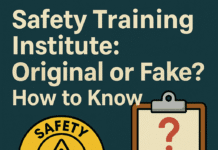
How SAMTRAC Can Enhance Your Skills as a Safety Officer
Introduction
The role of a Safety Officer is crucial in ensuring that workplaces are safe, well-regulated, and free from hazards. Whether you’re working in construction, oil and gas, or manufacturing, your job requires a deep understanding of risk management, safety protocols, and regulatory compliance. As industries evolve and workplace safety demands grow, continuous learning through certifications like SAMTRAC (Safety Management Training Course) is vital.
SAMTRAC, designed by the National Occupational Safety Association (NOSA), is one of the most widely recognized safety training programs globally. It equips professionals with practical skills and knowledge to excel in safety management roles. But how exactly can SAMTRAC enhance your abilities as a Safety Officer? Let’s explore this in detail.
What is SAMTRAC?
SAMTRAC is a safety management course that focuses on providing comprehensive knowledge of health, safety, and environmental regulations in industries like construction, oil and gas, and mining. Its primary goal is to equip professionals with the skills needed to reduce risks, prevent accidents, and promote a culture of safety.
SAMTRAC training covers:
- Risk assessments and hazard management
- Safety audits and compliance
- Environmental safety and sustainability
- Legal requirements and regulations
SAMTRAC’s practical and hands-on approach helps professionals apply what they’ve learned directly in their work environment.
Skills That SAMTRAC Develops
One of the key benefits of SAMTRAC is the wide range of critical skills it enhances, particularly in the role of a Safety Officer:
- Risk Assessment and Hazard Management: SAMTRAC provides you with the tools to identify potential hazards in the workplace, assess risks, and develop mitigation strategies. This ability is crucial in preventing accidents and ensuring the safety of employees.
- Effective Safety Audits and Inspections: SAMTRAC teaches you how to conduct thorough safety audits and inspections. These are essential in identifying non-compliance with safety regulations and minimizing risks.
- Environmental Safety Knowledge: Safety Officers need to be aware of environmental hazards as well. SAMTRAC offers in-depth insights into sustainable practices and environmental protection, preparing you to tackle environmental challenges in hazardous industries.
- Legal and Regulatory Compliance: SAMTRAC also covers the legal aspects of safety management, including national and international regulations. As a Safety Officer, staying up-to-date with laws is essential to maintain compliance and avoid costly legal issues.
Practical Applications of SAMTRAC in Safety Officer Roles
SAMTRAC certification isn’t just theoretical. Its practical applications are highly beneficial for Safety Officers. For example:
- In construction, you may use SAMTRAC skills to manage risks related to heavy equipment, scaffolding, and working at heights.
- In the oil and gas industry, SAMTRAC can help you implement safety protocols for handling hazardous materials, ensuring workers are protected from environmental disasters.
- In mining, SAMTRAC aids in creating safety procedures for underground operations, where hazards like cave-ins or exposure to toxic gases are prevalent.
How SAMTRAC Improves Safety Culture
A great Safety Officer doesn’t just ensure compliance but also fosters a safety-first culture within the organization. SAMTRAC plays a critical role in promoting this mindset by teaching professionals how to:
- Lead safety initiatives and advocate for a proactive safety culture
- Encourage workers to report hazards and near-misses
- Create an environment where safety is everyone’s responsibility, from top management to the newest hire
SAMTRAC and Career Advancement
Investing in SAMTRAC can significantly impact your career trajectory. Here’s how:
- Boosting Credentials: SAMTRAC certification adds value to your resume, making you stand out in the competitive safety job market.
- Opportunities for Promotion: With SAMTRAC, you increase your chances of moving into higher positions such as Safety Manager or Safety Supervisor.
- Improved Job Mobility: Companies around the world recognize SAMTRAC as a reliable certification, giving you opportunities to work abroad or switch industries.
Comparing SAMTRAC with Other Safety Certifications
When compared to other safety management certifications like NEBOSH and IOSH, SAMTRAC is often more practical and industry-focused. While NEBOSH and IOSH offer more theoretical content and a broader scope, SAMTRAC is tailored for hands-on, risk-heavy industries. It’s ideal for professionals seeking specialized knowledge in sectors such as oil and gas, mining, and construction.
The Benefits of SAMTRAC for Safety Officers
The practical benefits of SAMTRAC for Safety Officers are evident in various ways:
- Hands-on Experience: SAMTRAC’s interactive approach allows you to apply safety concepts in real-world scenarios.
- Mastering Industry-Specific Regulations: It helps you understand and navigate the complex legal frameworks and regulations specific to your industry.
- Enhanced Leadership and Communication Skills: As a Safety Officer, you’ll often need to lead safety meetings and communicate safety guidelines. SAMTRAC enhances these essential skills, allowing you to influence positive safety behavior in the workplace.
Why SAMTRAC is Essential for Safety Officers in High-Risk Sectors
In high-risk industries like oil and gas, construction, and mining, specialized safety training is not just beneficial—it’s essential. SAMTRAC prepares Safety Officers to tackle industry-specific risks, ensuring the safety and well-being of workers. By equipping you with the knowledge to handle hazardous materials, machinery, and extreme working conditions, SAMTRAC helps mitigate risks in environments where safety is paramount.
How SAMTRAC Aligns with Industry Standards
SAMTRAC aligns closely with global safety standards, such as ISO and OSHA regulations. It ensures that Safety Officers not only meet legal requirements but also lead their organizations toward a safety culture that exceeds industry standards. This alignment makes SAMTRAC a valuable certification for both individual professionals and organizations aiming for higher safety performance.
How SAMTRAC Can Enhance Your Skills as a Safety Officer
Safety Officers play a crucial role in ensuring the health and safety of workers in various industries. As a Safety Officer, you are responsible for implementing safety protocols, conducting safety audits, and ensuring compliance with local regulations. One of the most effective ways to enhance your skills and advance your career in this field is by obtaining specialized certifications like SAMTRAC (Safety Management Training Course). In this article, we will explore how SAMTRAC can enhance your skills and make you a more effective Safety Officer.
What is SAMTRAC?
SAMTRAC, short for Safety Management Training Course, is a globally recognized certification designed to provide professionals with the knowledge and skills necessary to manage workplace health and safety effectively. It is often offered by leading safety organizations, such as the National Examination Board in Occupational Safety and Health (NEBOSH), and focuses on the principles of safety management, risk assessment, and safety legislation. SAMTRAC certification is highly regarded across industries, including construction, oil and gas, manufacturing, and more.
Key Benefits of SAMTRAC for Safety Officers
1. Improved Knowledge of Safety Regulations
SAMTRAC provides Safety Officers with an in-depth understanding of safety regulations and legal compliance. The course covers both local and international safety standards, enabling you to stay updated on the latest health and safety laws. This knowledge will allow you to ensure that your organization adheres to all necessary regulations, minimizing the risk of legal penalties and workplace accidents.
2. Enhanced Risk Management Skills
One of the key components of SAMTRAC is risk management. By completing the course, you will develop strong skills in identifying hazards, assessing risks, and implementing control measures to mitigate potential threats. With a solid understanding of risk management, you can effectively manage workplace hazards and prevent accidents before they occur.
3. Better Communication and Leadership Skills
As a Safety Officer, you often serve as the bridge between management and workers regarding safety concerns. SAMTRAC emphasizes the importance of communication and leadership skills, which are essential for effectively delivering safety messages and ensuring that all employees adhere to safety protocols. The course helps you develop strategies for fostering a safety culture within your organization, encouraging workers to participate in safety programs actively.
4. Advanced Accident Investigation Techniques
Understanding how to investigate accidents and incidents is an integral part of the Safety Officer’s role. SAMTRAC teaches advanced techniques for investigating workplace accidents, including root cause analysis. By mastering these techniques, you can identify the underlying causes of incidents and prevent future occurrences, thus improving overall safety in the workplace.
5. Practical Application of Safety Management Principles
SAMTRAC isn’t just theoretical. The course provides hands-on experience and real-world case studies that allow you to apply the safety management principles learned in the classroom to actual workplace situations. This practical knowledge ensures that you can immediately apply what you’ve learned to your role, making you more effective in your day-to-day responsibilities.
6. Career Advancement Opportunities
Obtaining SAMTRAC certification can significantly enhance your career prospects. It demonstrates to employers that you possess the necessary skills and knowledge to manage safety at a high level. Many organizations prioritize certified Safety Officers for promotions and leadership roles, and SAMTRAC can open doors to new job opportunities, higher salaries, and career growth.
7. Increased Credibility and Professional Recognition
SAMTRAC is a globally recognized certification, and completing it gives you instant credibility as a Safety Officer. Employers and colleagues will respect your expertise, and your skills will be recognized as being on par with international safety standards. This recognition can set you apart from other professionals in the field and increase your chances of landing higher-level positions in safety management.
How SAMTRAC Helps in Industry-Specific Safety Training
Every industry has its unique challenges when it comes to safety management. Whether you are working in construction, oil and gas, or manufacturing, SAMTRAC equips you with the tools and knowledge to address industry-specific safety concerns. The course can be tailored to suit the specific needs of your industry, allowing you to gain relevant insights and apply safety protocols effectively in your field.
Construction Industry
In the construction industry, hazards such as working at heights, heavy machinery, and confined spaces are prevalent. SAMTRAC prepares Safety Officers to recognize these dangers and implement strategies to reduce risks, ensuring workers’ safety on-site.
Oil & Gas Industry
The oil and gas industry presents unique challenges such as hazardous materials, high-risk work environments, and the need for strict safety protocols. SAMTRAC provides the knowledge necessary to manage safety in these demanding environments and ensure compliance with industry-specific regulations.
Manufacturing Industry
Manufacturing environments often involve working with heavy machinery, chemicals, and fast-paced workflows. SAMTRAC teaches safety techniques that are particularly relevant to manufacturing processes, helping Safety Officers ensure a safer working environment.
Conclusion
SAMTRAC is more than just a certification—it’s a tool for developing the practical skills you need to excel as a Safety Officer. From risk management and hazard analysis to legal compliance and leadership, SAMTRAC enhances your ability to protect workers and create a safer workplace. Whether you’re just starting your career or aiming for a promotion, SAMTRAC is a valuable investment in your professional development.
Types of Safety Career and Its Scope
National Association of Safety Professionals (NASP)
Associate Safety Professional (ASP) Certificate Course
Certified Safety Professional (CSP) Certificate Course
FAQs
- How long does the SAMTRAC certification take to complete?
- SAMTRAC courses typically range from a few days to a few weeks, depending on the level and delivery method.
- Is SAMTRAC recognized globally?
- Yes, SAMTRAC is recognized internationally, especially in industries like construction, oil and gas, and mining.
- What makes SAMTRAC different from other safety training courses?
- SAMTRAC is more practical and industry-specific, focusing on high-risk sectors and offering hands-on training.
- How can SAMTRAC help improve workplace safety?
- SAMTRAC equips Safety Officers with the knowledge to manage risks, enforce safety protocols, and foster a safety-first culture within the organization.
- Is SAMTRAC suitable for all industries?
- While SAMTRAC is ideal for high-risk sectors like oil & gas, construction, and mining, its principles can be applied across various industries.
























